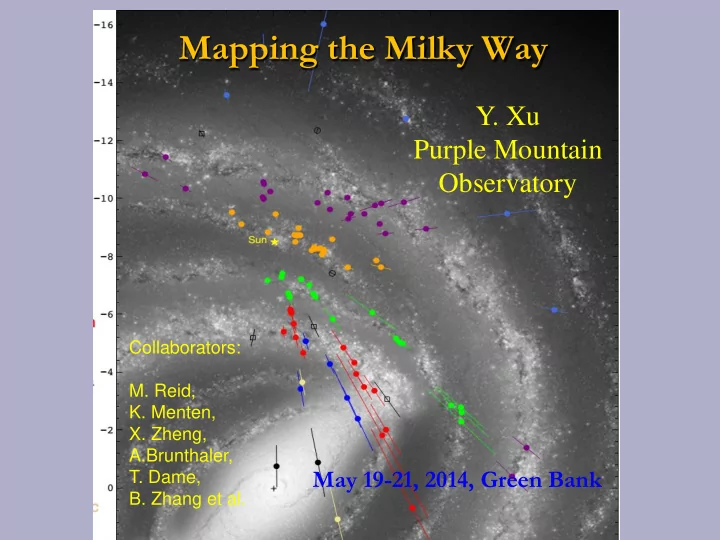

Mapping the Milky Way Y. Xu Purple Mountain Observatory Collaborators: M. Reid, K. Menten, X. Zheng, A.Brunthaler, May 19-21, 2014, Green Bank T. Dame, B. Zhang et al.
The First Evidence for Spiral Structure of MW Milky Way Inside the Milky Way, edge-on, Morgan et al. 1952, 1953
Models Steiman-Cameron 2010
No Arm ! Open clusters (age < 2 × 10^7 yr) No arm ! Janes & Adler 1982
Large-scale structures H I CO Giants
Large distance uncertainty Difficulties in determining an accurate rotation curve Non-Circular Rotation Kinematic Distance Ambiguity G9.62+0.20: far kinematic dist. 15 kpc near 0.5 kpc Parallax Distance 5.7 kpc Kinematically anomalous W3OH: Kinematic Distance ~ 4.3 kpc Parallax Distance ~ 2.0 kpc
The VERA & BeSSeL Survey VLBI Exploration of Radio Astrometry • ~ 1000 masers • will yield accurate distances to most HMSFR, locate the spiral arms and the bar, measure R 0 and Θ 0 to ~1%, and measure the rotation curve.
Cygnus X Star forming complex (Masers) Rygl et al. (2012)
All parallax results • Results of parallaxes from VLBA, VERA & EVN: • ~ 100 sources • Strong evidence for spiral arms • Inner, bar-region & outer arm ⇒ large uncertainty Reid et al. 2014 Background: artist conception by Robert Hurt (NASA: SSC)
Counter-Rotation of Star Forming Regions Compute Galactic-centric V Transform to frame rotating at Θ o = 245 km/s ( yellow ) See peculiar (non-circular) motions …clear counter-rotation Transform to frame rotating at Θ o = 220 km/s (red) Still counter-rotating But is sensitive to Solar Motion…
Change on Solar motion Until 2009, the Dehnen & Binney (1998) HIPPARCOS Solar motion of U 0 =10.00 ± 0.36 km/s (radially inwards), V 0 = 5.25 ± 0.62 km/s (in the direction of Galactic rotation), W 0 = 7.17 ± 0.38 km/s (vertically upwards) was widely accepted. After part of parallax results published, HIPPARCOS revised: Schoenrich, Binney & Dehnen (2010) U 0 = 11.1 ± 2.0 k/ms, V 0 = 12.2 ± 2.1 km/s, W 0 = 7.2 ± 2.0 km/s NEW : V 0 = 14.6 ± 5.0 k/ms (Reid et al. 2014)
Large distance uncertainty ⇒ in-beam calibrators Systematic errors ∝ angular separation i.e., W3OH: 0.5+/- 0.010 mas (0.8 ° ) 0.5+/- 0.017 mas (1.5 ° ) 1. SNR/Sensitivity : Masers: flux density threshold for phase-ref 5 Jy for 22 GHz H 2 O & 12.2 GHz CH 3 OH ~200/2000 2 Jy for 6.7 GHz CH 3 OH 400/2000 2. Weak station geometry in Southern hemisphere → Large field of view or/and sensitivity
Now & Future VLBA+ LBA+ SKA
Future VLBI Astrometry ---- SKA large field of view & sensitivity - Target sources Masers: 1000 → 6000; - Calibrators QSOs: 10 4 → 10 6 - Accuracy Several in-beam calibrators Systematic errors greatly reduced Parallaxes of ~ 1 µ as
Conclusions VLBA, VERA & EVN parallaxes to young stars tracing spiral structure of MW Star forming regions “ counter-rotate ” by ~5 km/s SKA will construct the accurate the spiral structure of MW finally
Recommend
More recommend